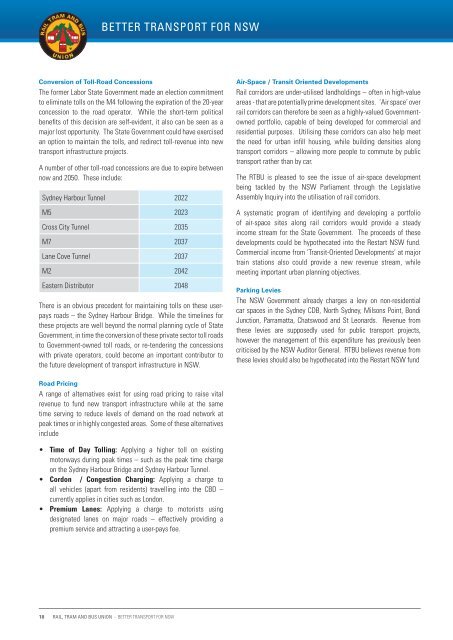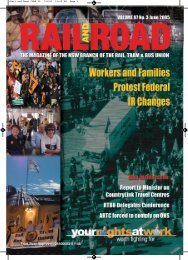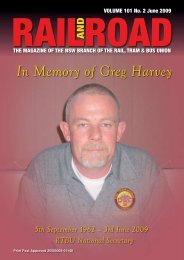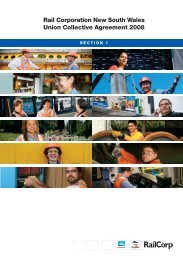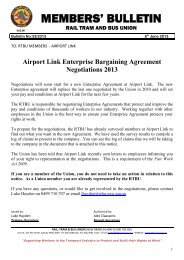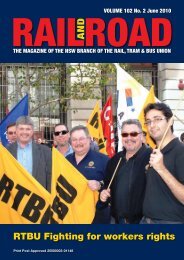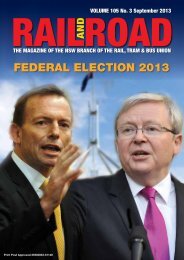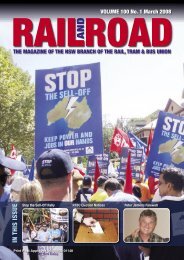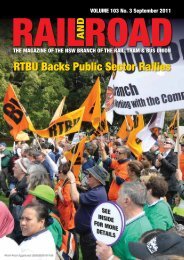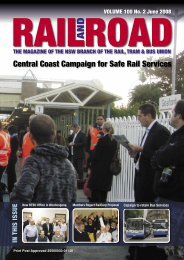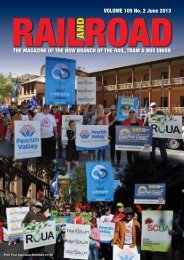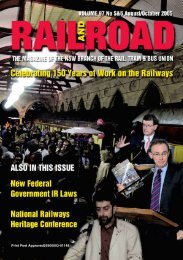Better Transport for NSW - Rail, Tram and Bus Union of NSW
Better Transport for NSW - Rail, Tram and Bus Union of NSW
Better Transport for NSW - Rail, Tram and Bus Union of NSW
You also want an ePaper? Increase the reach of your titles
YUMPU automatically turns print PDFs into web optimized ePapers that Google loves.
BETTER TRANSPORT FOR <strong>NSW</strong><br />
Conversion <strong>of</strong> Toll-Road Concessions<br />
The <strong>for</strong>mer Labor State Government made an election commitment<br />
to eliminate tolls on the M4 following the expiration <strong>of</strong> the 20-year<br />
concession to the road operator. While the short-term political<br />
benefits <strong>of</strong> this decision are self-evident, it also can be seen as a<br />
major lost opportunity. The State Government could have exercised<br />
an option to maintain the tolls, <strong>and</strong> redirect toll-revenue into new<br />
transport infrastructure projects.<br />
A number <strong>of</strong> other toll-road concessions are due to expire between<br />
now <strong>and</strong> 2050. These include:<br />
Sydney Harbour Tunnel 2022<br />
M5 2023<br />
Cross City Tunnel 2035<br />
M7 2037<br />
Lane Cove Tunnel 2037<br />
M2 2042<br />
Eastern Distributor 2048<br />
There is an obvious precedent <strong>for</strong> maintaining tolls on these userpays<br />
roads – the Sydney Harbour Bridge. While the timelines <strong>for</strong><br />
these projects are well beyond the normal planning cycle <strong>of</strong> State<br />
Government, in time the conversion <strong>of</strong> these private sector toll roads<br />
to Government-owned toll roads, or re-tendering the concessions<br />
with private operators, could become an important contributor to<br />
the future development <strong>of</strong> transport infrastructure in <strong>NSW</strong>.<br />
Air-Space / Transit Oriented Developments<br />
<strong>Rail</strong> corridors are under-utilised l<strong>and</strong>holdings – <strong>of</strong>ten in high-value<br />
areas - that are potentially prime development sites. ‘Air space’ over<br />
rail corridors can there<strong>for</strong>e be seen as a highly-valued Governmentowned<br />
portfolio, capable <strong>of</strong> being developed <strong>for</strong> commercial <strong>and</strong><br />
residential purposes. Utilising these corridors can also help meet<br />
the need <strong>for</strong> urban infill housing, while building densities along<br />
transport corridors – allowing more people to commute by public<br />
transport rather than by car.<br />
The RTBU is pleased to see the issue <strong>of</strong> air-space development<br />
being tackled by the <strong>NSW</strong> Parliament through the Legislative<br />
Assembly Inquiry into the utilisation <strong>of</strong> rail corridors.<br />
A systematic program <strong>of</strong> identifying <strong>and</strong> developing a portfolio<br />
<strong>of</strong> air-space sites along rail corridors would provide a steady<br />
income stream <strong>for</strong> the State Government. The proceeds <strong>of</strong> these<br />
developments could be hypothecated into the Restart <strong>NSW</strong> fund.<br />
Commercial income from ‘Transit-Oriented Developments’ at major<br />
train stations also could provide a new revenue stream, while<br />
meeting important urban planning objectives.<br />
Parking Levies<br />
The <strong>NSW</strong> Government already charges a levy on non-residential<br />
car spaces in the Sydney CDB, North Sydney, Milsons Point, Bondi<br />
Junction, Parramatta, Chatswood <strong>and</strong> St Leonards. Revenue from<br />
these levies are supposedly used <strong>for</strong> public transport projects,<br />
however the management <strong>of</strong> this expenditure has previously been<br />
criticised by the <strong>NSW</strong> Auditor General. RTBU believes revenue from<br />
these levies should also be hypothecated into the Restart <strong>NSW</strong> fund<br />
Road Pricing<br />
A range <strong>of</strong> alternatives exist <strong>for</strong> using road pricing to raise vital<br />
revenue to fund new transport infrastructure while at the same<br />
time serving to reduce levels <strong>of</strong> dem<strong>and</strong> on the road network at<br />
peak times or in highly congested areas. Some <strong>of</strong> these alternatives<br />
include<br />
• Time <strong>of</strong> Day Tolling: Applying a higher toll on existing<br />
motorways during peak times – such as the peak time charge<br />
on the Sydney Harbour Bridge <strong>and</strong> Sydney Harbour Tunnel.<br />
• Cordon / Congestion Charging: Applying a charge to<br />
all vehicles (apart from residents) travelling into the CBD –<br />
currently applies in cities such as London.<br />
• Premium Lanes: Applying a charge to motorists using<br />
designated lanes on major roads – effectively providing a<br />
premium service <strong>and</strong> attracting a user-pays fee.<br />
18<br />
RAIL, TRAM AND BUS UNION - BETTER TRANSPORT FOR <strong>NSW</strong>


